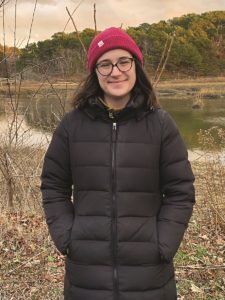Sophia Maymudes has always had her own, perhaps odd, way with words. She remembers defining the word ungulate for her parents when it appeared in a clue of a crossword puzzle they were solving. They didn’t know the word. But she had just learned that it meant “a hoofed mammal” from her Magic School Bus game. She was five years old at the time.

She started solving crosswords when she was in middle school, says Maymudes, who now constructs them for the Provincetown Independent and, from time to time, for the New York Times. She and her mother would work on the Monday and Tuesday Times crosswords together. The puzzles get progressively more difficult from Monday to Saturday.
When she started complaining about crosswords she didn’t like, Maymudes says, her parents told her to make her own. Maymudes downloaded CrossFire, software for constructing crosswords, and by her sophomore year at Carleton College, where she majored in computer science and minored in math, she was publishing them in the school newspaper.
Now two years out of college, Maymudes lives in Seattle and works as a software engineer at Google. “I went into tech because it’s the closest I could come to professional puzzle solving,” she says.
Maymudes has spent most of her summers in Wellfleet, just as her mother, Emily Anthony, did (and still does, though now Anthony travels to the Cape from Seattle, Maymudes’s hometown). Her aunt is the Wellfleet artist Sue Anthony. This is a place of family get-togethers. And Maymudes took refuge here with a pod of college friends during the early months of Covid, from March to September 2020.
Maymudes started creating puzzles for the Independent in 2019 and says she enjoys making ones that are “so Cape-specific I could never publish them anywhere else.” In October 2020, she constructed one called “You Are Here,” which was situated in a grid that looked like Cape Cod.
That puzzle was a peculiar one in Maymudes’s portfolio because it wasn’t symmetrical. She nixed that for the sake of the theme.
Symmetry in crosswords can be vertical, horizontal, or diagonal, and is one of several arbitrary standards, Maymudes says, that are attributable to the 27-year reign of the inaugural New York Times crossword editor, Margaret Farrar. Farrar, who held that role from 1942 to 1969, is also credited with establishing the three-letter-word minimum for crossword answers.
While symmetry is technically optional, Maymudes says she likes building around constraints. “It’s more satisfying to me as a constructor to make puzzles following the rules,” she says.
Symmetry is an often-discussed matter in the crossword community, which Maymudes has delved into, befriending fellow constructors on platforms like Twitter and Discord — a digital chat that hosts a crossword construction focus group. Collaborating on Discord is useful for people who don’t have friends who are into puzzles, Maymudes says, though she is often in the company of devotees and usually has her parents or friends test-solve her puzzles.
She is also part of the Discord channel for discussing each day’s New York Times crossword. One channel, called “is-this-word-legit,” is specifically for discussions about which words are and are not reasonable to include in clues and answers.
“Do you write clues or make the grid first?” I asked.
“There’s a joke in the crossword constructor community about that question,” Maymudes told me. With patience, she explained why it’s a nonsensical question: you can’t write clues until the words have been decided.
Before making a new puzzle, Maymudes decides whether it will have a theme. Hers usually do, for the same reason that they tend to be symmetrical — she likes working within constraints. Once she’s landed on a theme, she decides what the answers are going to be. Starting with a blank grid, she places her themed answers and blacks out squares that are not needed. The process involves a lot of trial and error.
On the subject of themes, disputes abound among crossword enthusiasts. Should crossword clues and answers be linked by one concept, as the ones she writes for the Independent are, or can they run free? Maymudes loves a good theme but knows that what’s good depends on the solver’s taste more than the maker’s.
Maymudes attended her first crossword tournament three years ago and says she was “totally starstruck” watching top performers. Tournament puzzle-solving is scored on a combination of speed and accuracy, at which she describes herself as being “very average.”
So far, eight of Maymudes’s puzzles have been published in the New York Times. She solves the Times puzzle every day now in addition to regularly doing the ones published by the New Yorker, the American Values Crossword Club, and the Inkubator, a puzzle subscription site featuring crosswords by women and nonbinary constructors.
Among her friends, Maymudes is often “the crossword person” in the group. But because she knows a lot of crossword experts, she doesn’t always get to feel that way. “It’s really fun to be that person,” she admits.



